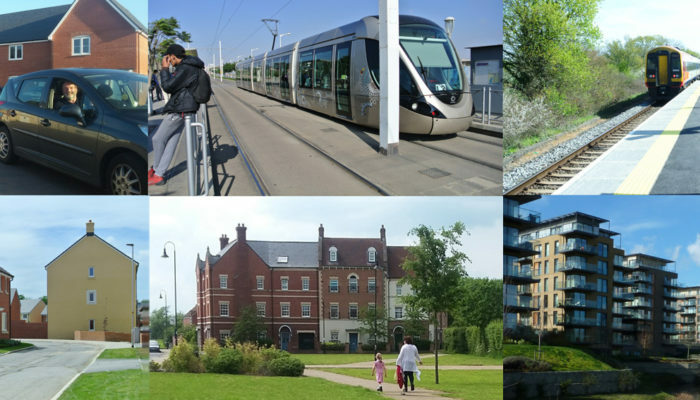
The Transport Knowledge Hub has done great work in highlighting the disconnect between sustainable transport and the location of new development. Now campaigning group Transport for New Homes has come up with a new checklist which can help assess new housing proposals on what their impact on the transport system will be, and whether the proposals will give those living in and around them ways of getting around without being entirely car dependent.
Since 2016 Transport for New Homes has been looking at housing developments on the ground, researching the ways they manage transport and highlight ways to make things better. Its initial report last year looked in detail at 20 urban extensions and lessons that can be drawn from them in transport terms.
Broadly the research found that housing is being built in locations, and with design and layout, that entrench dependence on car travel, with no local facilities and services, and poor public transport. In the worst cases there are no pavements connecting new developments with surrounding areas. These developments are also dominated by lots of surface car parking and have limited or no green space. As well as being a poor deal for residents, they add to congestion on surrounding roads, as well as to overall carbon emissions.
However, there are exceptions- some developments like Poundbury or Bath Riverside have better design, are less dominated by car parking and have high levels of walking and cycling.
To take this research further, Transport for New Homes has developed a checklist for new developments which aims to start from the good practice identified in the report and give people the tools to assess proposals for new housing. It will allow people to check if sites are appropriate for housing development, and also aims to expose plans for housing that are likely to result in car-dependent lifestyles, and to identify the reasons and ways in which development proposals can be improved. It will also help to assess the outcomes of developments already built so that lessons can be learnt.
- The starting point is to check if the location avoids car dependency. The checklist asks if the new development is in a location within or by an existing settlement that has a clear centre, and is supported by clear commitments to walking, cycling and public transport, including mode-share targets. It also asks if car use to residents’ main destinations is discouraged (e.g. by town centre parking charges or bus priority routes).
- The checklist gives various criteria for non-car access and travel. It asks whether the development is connected to key destinations by excellent public transport or there are confirmed plans for this to be in place from day 1 of occupation. The checklist goes into some detail on what “excellent public transport” means in practice – high frequency, 7 days a week and evenings, priority over other traffic, and with stops/stations within easy walking distance of all parts of the development. It also asks a lot of questions about walking and cycling – whether there are direct pavements and paths separated from heavy traffic and uninterrupted across side streets and driveways, secure cycle parking in all dwelling, and logical, direct walking and cycle routes to connect the development to the wider area and key destinations.
- The checklist looks at the general aspects of the development – whether it is built at a sufficient density to support high quality public transport if it has (or has firm commitments for) local facilities easily accessible without a car. More generally, it asks whether the development will have a welcoming environment, not dominated by car parking, with green space for relaxation and children’s play areas.
- Finally the checklist asks about car parking – whether ground level parking dominates the street scene, and how parking is to be organised to avoid encouraging car use and negative impacts on walking, cycling and bus operation. It also asks if there will be provision for shared “car club” vehicles and electric vehicle charging points.
The checklist is being used to judge entries for Transport for New Homes’ Award, which will recognise recent housing developments which have been located and designed to ensure that residents do not need cars to live a full life.
Transport for New Homes hopes the checklist will help to improve the quality of new housing development and reduce car dependency. Please contact us for more information.
About the Author
This post was written by Stephen Joseph. Stephen is a visiting professor at the University of Hertfordshire’s Smart Mobility Unit. He is a trustee of the Foundation for Integrated Transport, adviser to Transport for New Homes and was chief executive of the Campaign for Better Transport 1988-2018.
